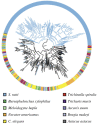Invade or die: behaviours and biochemical mechanisms that drive skin penetration in Strongyloides and other skin-penetrating nematodes
- PMID: 38008119
- PMCID: PMC10676818
- DOI: 10.1098/rstb.2022.0434
Invade or die: behaviours and biochemical mechanisms that drive skin penetration in Strongyloides and other skin-penetrating nematodes
Abstract
Skin-penetrating nematodes, including the human threadworm Strongyloides stercoralis and hookworms in the genera Necator and Ancylostoma, are gastrointestinal parasites that are a major cause of neglected tropical disease in low-resource settings worldwide. These parasites infect hosts as soil-dwelling infective larvae that navigate towards hosts using host-emitted sensory cues such as odorants and body heat. Upon host contact, they invade the host by penetrating through the skin. The process of skin penetration is critical for successful parasitism but remains poorly understood and understudied. Here, we review current knowledge of skin-penetration behaviour and its underlying mechanisms in the human parasite S. stercoralis, the closely related rat parasite Strongyloides ratti, and other skin-penetrating nematodes such as hookworms. We also highlight important directions for future investigations into this underexplored process and discuss how recent advances in molecular genetic and genomic tools for Strongyloides species will enable mechanistic investigations of skin penetration and other essential parasitic behaviours in future studies. This article is part of the Theo Murphy meeting issue 'Strongyloides: omics to worm-free populations'.
Keywords: Strongyloides; astacins; hookworms; sensory behaviour; skin penetration; skin-penetrating nematode.
Conflict of interest statement
We declare we have no competing interests.
Figures



Similar articles
-
Terror in the dirt: Sensory determinants of host seeking in soil-transmitted mammalian-parasitic nematodes.Int J Parasitol Drugs Drug Resist. 2018 Dec;8(3):496-510. doi: 10.1016/j.ijpddr.2018.10.008. Epub 2018 Oct 26. Int J Parasitol Drugs Drug Resist. 2018. PMID: 30396862 Free PMC article. Review.
-
Skin-penetrating nematodes exhibit life-stage-specific interactions with host-associated and environmental bacteria.BMC Biol. 2021 Oct 7;19(1):221. doi: 10.1186/s12915-021-01153-7. BMC Biol. 2021. PMID: 34620172 Free PMC article.
-
Thermosensory behaviors of the free-living life stages of Strongyloides species support parasitism in tropical environments.PLoS Negl Trop Dis. 2024 Dec 17;18(12):e0012529. doi: 10.1371/journal.pntd.0012529. eCollection 2024 Dec. PLoS Negl Trop Dis. 2024. PMID: 39689121 Free PMC article.
-
A Critical Role for Thermosensation in Host Seeking by Skin-Penetrating Nematodes.Curr Biol. 2018 Jul 23;28(14):2338-2347.e6. doi: 10.1016/j.cub.2018.05.063. Epub 2018 Jul 12. Curr Biol. 2018. PMID: 30017486 Free PMC article.
-
Astacin metalloproteases in human-parasitic nematodes.Adv Parasitol. 2024;126:177-204. doi: 10.1016/bs.apar.2024.03.001. Epub 2024 Apr 14. Adv Parasitol. 2024. PMID: 39448190 Review.
Cited by
-
Myeloid-derived IL-33 drives γδ T cell-dependent resistance against cutaneous infection by Strongyloides ratti.J Immunol. 2025 Mar 1;214(3):502-515. doi: 10.1093/jimmun/vkae038. J Immunol. 2025. PMID: 40073150
-
Intestinal parasitic infections and predisposing factors among prison inmates in Southern Ghana: A cross-sectional study.Health Sci Rep. 2024 May 7;7(5):e2087. doi: 10.1002/hsr2.2087. eCollection 2024 May. Health Sci Rep. 2024. PMID: 38721589 Free PMC article.
-
Strongyloides: omics to worm-free populations.Philos Trans R Soc Lond B Biol Sci. 2024 Jan 15;379(1894):20220448. doi: 10.1098/rstb.2022.0448. Epub 2023 Nov 27. Philos Trans R Soc Lond B Biol Sci. 2024. PMID: 38008116 Free PMC article.
-
Dopamine signaling drives skin invasion by human-infective nematodes.bioRxiv [Preprint]. 2025 Jan 30:2025.01.29.635547. doi: 10.1101/2025.01.29.635547. bioRxiv. 2025. PMID: 39974984 Free PMC article. Preprint.

